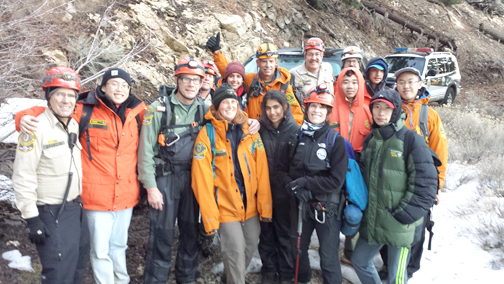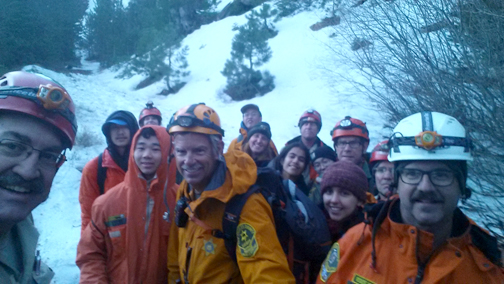
A hiking club from UCLA was full of happy faces after Montrose Search and Rescue team members led them out of the forest in icy, wet weather.
By Mary O’KEEFE
With the weekend approaching and as the east coast and Midwest continue to get hammered with snow, ice and below freezing temperatures, California is looking at a bit of a mini heat wave. The clear, warm weather entices people to enjoy the great outdoors, perhaps with a hike on local trails. This is great exercise and a lot of fun, but hikers should file a plan and be prepared for the worst. Outings can quickly change from a short, sunny hike to an uncomfortable, cold overnight stay.
“There should be a plan and everyone [on the hike] should know the plan,” advised Mike Leum, Los Angeles County Sheriff’s Dept. assistant director for the Reserve Forces Bureau and a member of the Montrose Search and Rescue team.
When hiking, it is always hope for the best – that trails are clear with no surprise rainstorms – but then plan for the worst – getting lost or injured with no cellphone service.
MSR Reserve Captain John Camphouse shares the 10 essentials that he teaches his Boy Scout troop: Bring a Swiss Army style knife, a waterproof backpack, fire starters, flashlight, compass, water, food, a hat, waterproof clothing and a first aid kit.
“And fill out a hiking plan,” Camphouse added.
Even for those who are experienced hikers and have traveled trails often, there is always something new to learn about being prepared for the next hike.
Hiker Jocelyn Bailey learned a few new things she could do to be better prepared after a day hike in the sun turned into a cold night in the Angeles National Forest.
Bailey is the co-president of the Hiking Club at UCLA. The club members, all college age, hike once or sometimes twice a week and have varying levels of experience. On Saturday their plan was simple: hike up to Mt. Hawkins.
“It is a 13-mile hike,” Bailey said. “We had [finished] our intended hike. During the day we had some snow on the trail and some rain.”
As the group of 13 continued their way back to their vehicles, the trail became a little more difficult with snow and fog setting in. Five of the members were a little faster than the others; Bailey was in the back of the group making certain the less experienced were not left behind.
“At some point the [three members] got ahead of us and took the [correct] fork in the trail,” she said. “I was with the other group and [we] missed that fork. We kept going on the trail not realizing [we were wrong].”
By the time that group of eight realized they had missed the turn, it was dark and the fog had set in.
Cell service in Angeles National Forest is spotty at best.
“We were trying to get a call through to 9-1-1,” she said. “It was hard, [9-1-1 dispatch] was asking us our specific location and then we would lose service.”
The group was able to get some service briefly and found their location with GPS (global positioning system).
“We realized we were pretty far out and it was not going to be easy to [get to the cars],” she said.
The group discussed their options – to begin retracing their steps, to attempt to find another way to the highway or to stay in place and wait for 9-1-1 to send someone. They decided because of the weather conditions to wait.
“We knew going back would be dangerous, and we were tired and cold. We decided to hunker down and get protection from the wind,” she said.
MSR was called out to assist San Dimas Mountain Rescue team at about 6 p.m.
“We were told there were five to six people missing and they were in the Throop Peak area,” Camphouse said.
The team had some information on the hikers’ location and eventually found the cars parked at the Islip Saddle trailhead. Because the cars belonged to the eight lost hikers, the first five who made it back to the trailhead had to make other arrangements to get back to UCLA.
“They did let [people] know where we were,” said Bailey.
However, that information may have not been communicated as well as Bailey thought since search and rescue teams did not have the group’s exact location.
“When we first got [on the trail] it was 45 degrees [Fahrenheit] and raining,” Camphouse said.
MSR team members split up and entered the trail from two areas, working their way to the middle to find the missing hikers.
“[My group] started from the west and another from the north,” Leum said.
They began their hike into the area at 9:15 p.m.
“The trail goes up and there were patches of snow, then you would hike through dirt then snow again,” Camphouse said.
As the MSR members walked the trail they called out to the missing hiking group. Bailey and her group heard the search and rescue voices calling.
“That was crazy,” she said. “[I said], ‘Wait, I hear voices.’”
Everyone was quiet and they all heard the calls from the team members.
“Someone is coming. Oh my God they came for us,” Bailey said in describing her first thoughts after hearing and then seeing the rescuers.
They had been “hunkered” down from 6 p.m. to about 1 a.m.
“In my 20-some years of rescues I don’t think I have ever seen anyone so happy to see us,” Leum said.
The hiking club members were wet, cold and hungry. Many were wearing tennis shoes and cotton clothing that the rain had soaked through.
MSR members gave them jackets and food and they began the long hike back. By this time the snow had turned to ice and in one area the team had to lower the club members down one by one on a rope because the slope was too dangerous for them to traverse. This alone took over an hour.
Bailey said she learned from the experience.
“It’s important, even if you think people know what kind of hike you are getting into, you need a reminder [to be prepared for] weather conditions,” she said. “And always talk to the people on the hike to see what their current situation is … to assess each person.”
She added that in a big group it is easy for someone to be cautious about voicing their concerns. She also has learned that everyone should know the trail they are on.
Sometimes it can be sunny in La Crescenta but snowy and icy on the mountain trails. That is why it is important to plan for the unexpected, Leum said.
On Wednesday, MSR assisted in the search for a missing man who had been hiking with his brother on Mt. Baldy. Both men are in their 70s and were missing for all of Tuesday night. Then the two brothers become separated. One of the men walked out of the area near San Antonio Falls on Wednesday morning, uninjured but cold and hungry. Search and rescue teams continued to look for the other man, who was found about 12:30 p.m. on Wednesday.
Camphouse said this is another reason to remember to not go alone when hiking. Two people are good but three is better, he said. If one person is injured, one can stay with the injured while another hikes out.
Whether hiking on a short trail or planning a long day hike, it is important to fill out the LASD hiking plan which can be found at the CVW website or by scanning the QR code with this story.
Bailey is undeterred in her desire to hike. She plans to go hiking this weekend not with the club, but with friends. The club will continue to hike every week as well.
When asked what she would like to say to MSR, she replied, “Oh man that is so hard. We are very grateful for what they did. It was very impressive. When we called them it was already dark. They realized how far out we were and they hiked [in for us] and then another five hours out. That says a lot about their character.”

